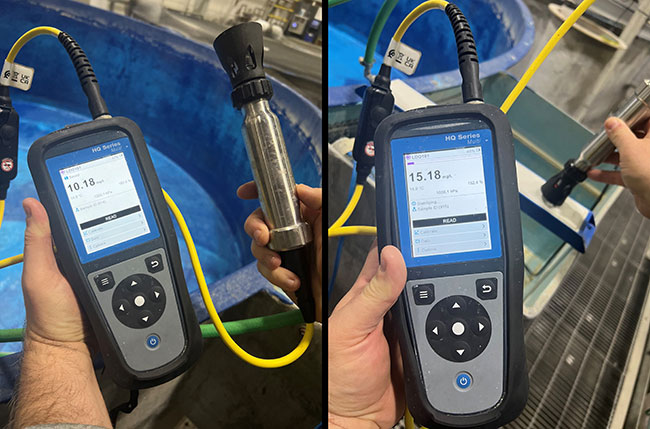
Features
Fresh Tips: Hacks for your RAS operations
May 17, 2024 By Curtis Crouse
 Dissolved oxygen probe on the left is reading near 100% saturation in the ambient environment. The probe on the right is detecting a supersaturated environment when held near a working oxygen diffuser.
Photo: Freshwater Institute
Dissolved oxygen probe on the left is reading near 100% saturation in the ambient environment. The probe on the right is detecting a supersaturated environment when held near a working oxygen diffuser.
Photo: Freshwater Institute Effective operation and management are as critical to the success of a RAS facility as proper design, capital investment, or marketing. Operations and management can include everything from equipment cleaning and maintenance to checking and servicing alarming and backup equipment or ordering, storing, and administering feed. Developing efficient methods and techniques can help keep your RAS facility running effectively. In this article, you can read about a few RAS hacks to help you hack your RAS operations.
Don’t throw disinfectant out with the bath water
Adhering to a sound biosecurity plan reduces the risk of introducing and spreading pathogens in the RAS facility. One important component of a biosecurity plan is equipment disinfecting protocols.
Disinfectants can be expensive and traditional dip baths require large volumes of solution that can be fouled and diluted with repeated use. One technique to get more mileage out of your disinfectant is to mix the solution in a pump sprayer.
By using a fine mist from the pump sprayer to apply disinfectant to the equipment rather than bringing the equipment in contact with a large bath, less volume is required. Additionally, because the pump sprayer is portable, the disinfectant can be transported to where it is needed rather than maintaining a net dip station at each RAS unit. A pump sprayer is also handy for applying disinfectant to the tires and hard-to-reach areas of visiting vehicles.
Monitor feed waste in the tank discharge
Feed is the largest contributor to production costs for RAS. Accordingly, proper feeding is critical to achieving good feed conversion without waste from overfeeding.

Virkon disinfectant solution in a pump sprayer
A well-designed RAS should quickly remove solids, including wasted feed, from the culture tank. A way to instantly check for wasted feed is to capture or monitor the effluent stream from the culture tank during and immediately after a feeding event.
The exact method may vary by RAS design but could include temporarily routing the water through a settling basin, placing a collection basket under a standpipe, or even installing a length of clear piping to allow visual assessment. It is best to set up a collection apparatus just before or at the beginning of a feeding event and remove and quantify the number of uneaten pellets within a few minutes of the end of the feeding event. This gives instant feedback a manager can use to adjust the feed ratio to the RAS.
Locate oxygen gas leaks with your dissolved oxygen probe
Another significant cost for RAS production is oxygen. Leaks in oxygen supply lines and around fittings lead to waste and increased production costs. Every RAS facility should inspect oxygen lines and fittings for leaks at least once a year.
Situations may arise between checks where a suspected oxygen leak is present, but leak detecting solution or equipment is not. In a pinch, a handheld dissolved oxygen probe can be used to locate appreciable oxygen gas leaks. If held close to an oxygen leak, the dissolved oxygen probe will detect a supersaturated environment and can narrow down the search area.
Curtis Crouse is a research support specialist at The Conservation Fund’s Freshwater Institute in Shepherdstown, W. Va. (ccrouse@conservationfund.org)
Print this page
- Ace Aquatec appoints new sales and service manager in Chile
- Proximar Seafood reports progress toward first harvest